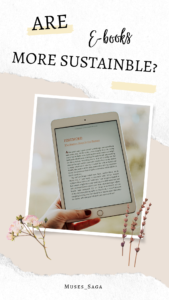Imagine this- you get up craving a new book. You reach for your e-reader, buy the book, and sit down in the sun to read your new e-book, feeling great because you are one of the people who made a switch to a more sustainable future.
Yet, if you are an occasional reader, this is not what will happen.

What? E-readers might not be as sustainable as they told us they are. What a surprise. No, not really.
Here’s the tea- e-books are more sustainable than paperbacks if you are someone who adores reading and reads 20+ books in a year.
However, what of those of us who read occasionally? Well, we will be unable to set off the impact of that new e-reader. At least not without a lot of e-books. Here’s why.
The impact of paperbacks is relatively well-known today. Yet let’s reiterate it in short. Cutting down trees, taking up more space in transportation, and the chemicals used to bind ink and paper all have a negative impact on the planet. Furthermore, if the books end up in landfills instead of being recycled, they add to their negative environmental impact. So does that mean e-books are more sustainable because they eradicate these problems?
The Impact of E-Books
E-books are more sustainable. That would be an easy assumption to make, but a false one. We all tend to think of the internet as a wide nebulous space but it isn’t like that. The data we see on the net is stored in data centers which has an impact. They use electricity to stay cool, for one. This electricity can come from fossil fuels. The same goes for the electricity used to charge our e-readers. And while e-readers, produce fewer emissions during transport, they are made of natural minerals such as cobalt, copper, and lithium. A single e-reader takes about 33 pounds of minerals to make. Experts say that mineral extraction and refining has a wide range of environmental impacts. These include mining wastes, water contamination, and air pollution from smelting.
It is estimated that producing one e-reader uses around 100 kilowatt hours of fossil fuels. It also uses 79 gallons of water. Emissions? 66 pounds of carbon dioxide.
So what do we do? Stop reading? Because both paperbacks and e-books have an environmental footprint. This is without considering the impact of blue light on human health and the conditions of workers in e-reader manufacturing factories.
Are other digital reading options a solution? Audiobooks? Reading online?
Audiobooks and digital reading can be enjoyed on the same device as the one you use for work or other purposes, which would make them more sustainable than an e-reader that can only be used to read books. However, they still require natural resources to make. The blue light emitted from them has an impact on human health. Plus, while the recycling of electronic products is gaining ground, it is not yet mainstream.
Which returns us to our original dilemma- how do we read sustainably? Because no one can deny how important reading is to human beings. From helping us learn a language to building empathy, both fiction and non-fiction play critical roles in our lives, after all.
So what’s the solution?
The answer lies in our reading habits. While e-readers can have multiple books thereby reducing their impact, their shelf-life is of three years, compared to a book which if taken care of can become a family heirloom. Furthermore, using recycled paper, print-on-demand technology, proper disposal, and eco-inks can reduce the impact of a book tremendously. Thus, depending on how much you read, either can be the more sustainable option.
If you are an occasional reader, ditch the e-book and pick up a library card or a recycled paperback of a book you love and will surely read again and again. Mike Berners-Lee, a professor of practice in Lancaster University’s Environment Centre, wrote in a post for New Scientist that a reader must go through at least 36 paperbacks that can be recycled to even-out an e-reader’s footprint.
Second, you need to do what suits your lifestyle for that will be the long-term change that creates an impact.
Third, proper disposal of your e-reader or book is critical as anything that ends up in a landfill is bad for the environment. Therefore recycling or donating or even re-selling books and e-readers you no longer want or need is a good idea.
However, the most sustainable option for the occasional reader remains libraries and sharing recycled paperbacks. Even reading online for too long can have health repercussions. Reading borrowed or second-hand books reduces the environmental impact of books significantly, whether they be paperbacks or in an electronic format.
Therefore, a book that can be read by multiple people multiple times for years on an end is the most sustainable option, no matter how many you read in a year, but especially if you read less than twenty books annually.
Scared that your reading habits go against your sustainable living ethics? Well, go on get a library card or find a eco-friendly online reading website.
Updated- 20/11/2023
Liked what you read? You can support Muses_Saga’s free online reading initiative by buying our team a book.
